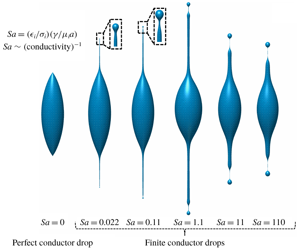Crossref Citations
This article has been cited by the following publications. This list is generated based on data provided by
Crossref.
Montanero, J M
and
Gañán-Calvo, A M
2020.
Dripping, jetting and tip streaming.
Reports on Progress in Physics,
Vol. 83,
Issue. 9,
p.
097001.
Abbasi, Muhammad
Song, Ryungeun
Cho, Seongsu
and
Lee, Jinkee
2020.
Electro-Hydrodynamics of Emulsion Droplets: Physical Insights to Applications.
Micromachines,
Vol. 11,
Issue. 10,
p.
942.
Singh, Mohit
Gawande, Neha
Mayya, Y. S.
and
Thaokar, Rochish
2021.
Subcritical asymmetric Rayleigh breakup of a charged drop induced by finite amplitude perturbations in a quadrupole trap.
Physical Review E,
Vol. 103,
Issue. 5,
Rubio, M.
Sadek, S. H.
Gañán-Calvo, A. M.
and
Montanero, J. M.
2021.
Diameter and charge of the first droplet emitted in electrospray.
Physics of Fluids,
Vol. 33,
Issue. 3,
Cheng, Jin-bo
Yang, Li-jun
Fu, Qing-fei
Ren, Jun-xue
Tang, Hai-bin
Sun, Da-kun
and
Sun, Xiao-feng
2022.
Pulsating modes of a Taylor cone under an unsteady electric field.
Physics of Fluids,
Vol. 34,
Issue. 1,
Tian, Yu
Liu, Yanchu
Peng, Zihan
Xu, Chenghao
Ye, Dong
Guan, Yin
Zhou, Xinping
Deng, Weiwei
and
Huang, YongAn
2022.
Air entrapment of a neutral drop impacting onto a flat solid surface in electric fields.
Journal of Fluid Mechanics,
Vol. 946,
Issue. ,
Gawande, Neha
Mayya, Y. S.
and
Thaokar, Rochish
2022.
Translation–deformation coupling effects on the Rayleigh instability of an electrodynamically levitated charged droplet.
The European Physical Journal E,
Vol. 45,
Issue. 5,
Gawande, Neha
Mayya, Y.S.
and
Thaokar, Rochish
2022.
Effect of conductivity on the mechanism of charge ejection in Rayleigh breakup of a charged drop.
Journal of Electrostatics,
Vol. 117,
Issue. ,
p.
103720.
Misra, Kaartikey
and
Gamero-Castaño, Manuel
2023.
Ion emission from nanodroplets undergoing Coulomb explosions: a continuum numerical study.
Journal of Fluid Mechanics,
Vol. 958,
Issue. ,
2023.
Regulating air cushioning and bubble entrapment in charged droplet impact via external electric fields.
Physics of Fluids,
Vol. 35,
Issue. 6,
Rubio, M.
Rodríguez-Díaz, P.
López-Herrera, J. M.
Herrada, M. A.
Gañán-Calvo, A. M.
and
Montanero, J. M.
2023.
The role of charge relaxation in electrified tip streaming.
Physics of Fluids,
Vol. 35,
Issue. 1,
Zhou, Xin
Wang, Hong
Zhang, Qian
Tian, Ye
Deng, Qiyuan
Zhu, Xun
Ding, Yudong
Chen, Rong
and
Liao, Qiang
2023.
Numerical study on jet and stretch behaviors of an impingement leaky-dielectric droplet under electric field.
International Journal of Multiphase Flow,
Vol. 167,
Issue. ,
p.
104531.
Behera, Nalinikanta
and
Chakraborty, Suman
2023.
Electric-field-mediated morpho-dynamic evolution in drop–drop coalescence phenomena in the inertio-capillary regime.
Journal of Fluid Mechanics,
Vol. 956,
Issue. ,
Mhatre, Sameer
2023.
Shape, stability and dynamics of a charged drop falling on a substrate.
Journal of Aerosol Science,
Vol. 172,
Issue. ,
p.
106188.
Zhang, Haodong
Wang, Fei
and
Nestler, Britta
2024.
Multi-component electro-hydro-thermodynamic model with phase-field method. I. Dielectric.
Journal of Computational Physics,
Vol. 505,
Issue. ,
p.
112907.
Montanero, José María
2024.
Tip Streaming of Simple and Complex Fluids.
Vol. 137,
Issue. ,
p.
111.
Chen, Hao
Wang, Guozhen
An, Tao
Yin, Zhouping
and
Fang, Haisheng
2024.
Modelling the first droplet emission from an electrified liquid meniscus hanging at the nozzle tip.
Journal of Fluid Mechanics,
Vol. 987,
Issue. ,
Chen, Chong
Fan, Yipeng
Xia, Guangqing
Lu, Chang
Sun, Bin
and
Han, Yajie
2024.
Ion evaporation-induced tip streaming from liquid drops of ionic liquids.
Physics of Fluids,
Vol. 36,
Issue. 3,
Wang, Guozhen
Chen, Wei
Chen, Jiankui
Hu, Chao
Chen, Hao
and
Yin, Zhouping
2024.
Pinch-off dynamics of an electrohydrodynamic tip streaming jet transforming into the microdroplet.
Physics of Fluids,
Vol. 36,
Issue. 7,
Ahumada Lazo, Jorge
and
Chen, Ruey-Hung
2024.
Self-similar behavior of successive Coulombic fissions of evaporating charged water droplets.
International Journal of Heat and Mass Transfer,
Vol. 219,
Issue. ,
p.
124879.



